The Pipits, Species of Birds
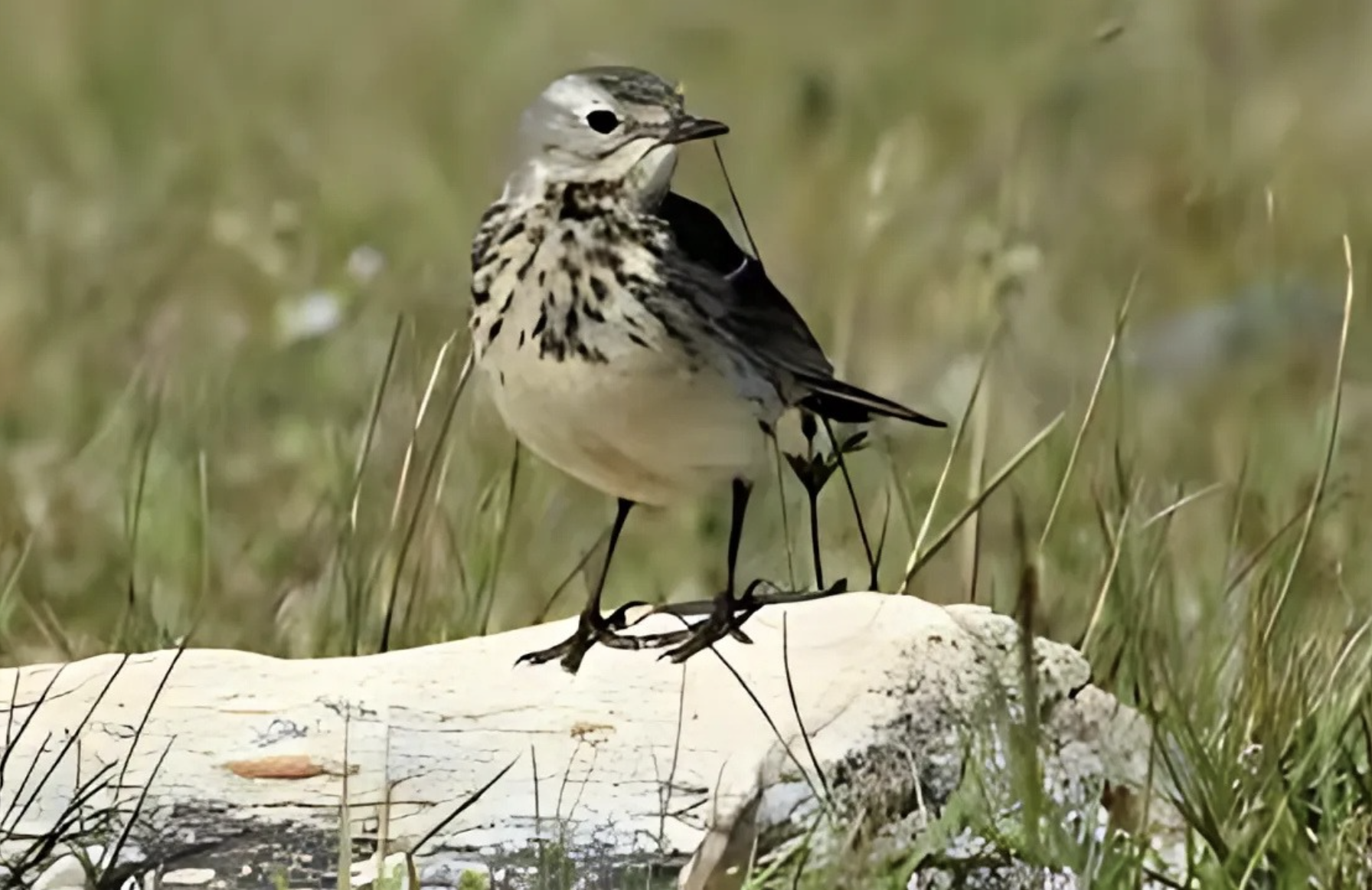
American Pipit
Photo Credit – American Bird Conservancy
There are about 40 pipit-named species worldwide, with the word “pipit” derived from the Meadow Pipit’s call “pi-pit.” Pipits are small, slender, drab-looking, streaky-brown birds with forenames often identifying their habitat, location, or coloring—such as American, Meadow, Tree, Water, Tawny, and Red-throated. Wolf Winter, a novel set in Swedish Lapland by Cecilia Ekback, mentions pipits and renewed my interest in these birds. I first saw pipits in the UK in the 1950s.
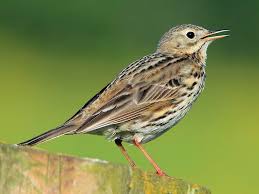
Meadow Pipit
Photo Credit – eBird
First, let me introduce you to the most common pipit in the United Kingdom: the Meadow Pipit, a mainly resident bird. However, some migrate as far as North Africa for winter, and because of their drabness and habitat among ground vegetation, they often go unnoticed. Their plumage is mainly brown above and buff below, with streaking on the upper breast. They are thin-billed and display an undulating flight pattern during which birders can spot their white tail feathers. You might mistake them for sparrows, but remember, sparrows hop on the ground, whereas pipits typically walk or run. Meadow Pipits feed off insects and worms and nest on the ground. Males and females look alike; their life span is three to five years. Also, they are a species where the Cuckoo commonly removes their eggs and lays its own in their nest.
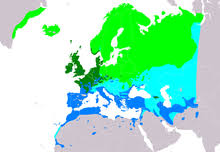
Meadow Pipit Range
Photo Credit – Wikipedia
Light green – Breeding; Dark green – Resident; Light blue – Passage; Dark blue – Non-breeding
Although UK numbers have declined since the 1970s, and the species is on the UK Amber List of Conservation, over two million pairs remain. The cause of the decline is believed to be more arable farming, the expansion of woodland, and possibly global warming pushing the population northwards. They are widely distributed across Europe and Asia, with an estimated global population of around 12 million pairs. They appear in Iceland and eastern Greenland but do not reach North America.
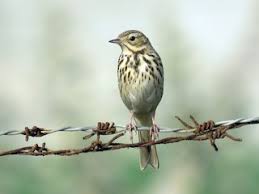
Tree Pipit
Photo Credit – eBird
Growing up, the Tree Pipits I spotted were usually near a thicket of trees next to a clover field on our farm and present only during summer. Both the birds and the trees have long since disappeared. They spent April to August breeding and then migrated to Sub-Saharan Africa, 6,000 miles (10,000 km) away. They look like Meadow Pipits but have more streaking on their chest and flanks and less contrast in color between their belly and flanks. They also have a distinctive call and flight behavior. The bird will launch out of a tree, soar upwards, then suddenly stiffen its wings and fall back into the tree. The Meadow Pipit does the same but starts from the ground. The birds’ diet consists mainly of invertebrates, although fruit and seeds sometimes supplement their food in winter. They nest on the ground and typically live for around two years. They are also vulnerable to the Cuckoo’s “brood parasitism”, where the Cuckoo uses the Tree Pipit and its nest to raise their young.
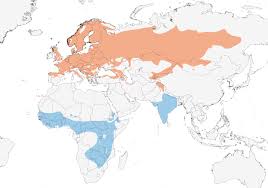
Tree Pipit Range
Photo Credit – Cornell Laboratory
Orange: Breeding; Blue Non-breeding
There are far fewer Tree Pipits in the UK than Meadow Pipits. Current estimates are about 100,000 pairs. Tree Pipits have suffered a severe decline in the UK since the 1970s, with its range reduced by 30 percent and its summer population falling up to 70 to 80 percent in some places. The reasons are unclear, and its cause may lie outside the UK. The species has been placed on the UK Red List of Conservation. Otherwise, the species is abundant across the rest of Europe and Asia, with about 35 million pairs in Europe and 70 million worldwide.
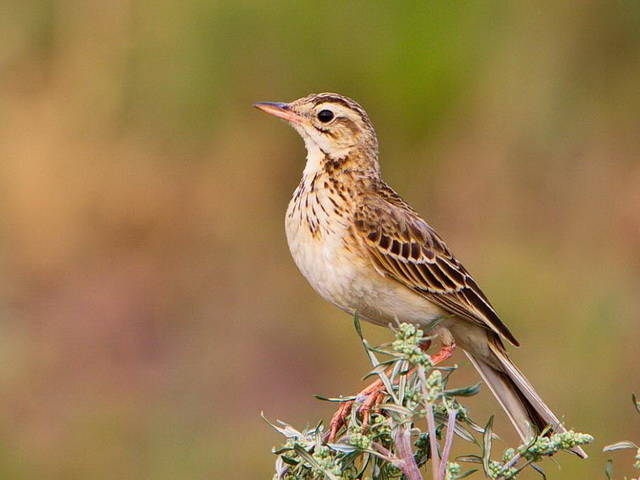
Richard’s Pipit
Photo Credit – Sibirds,ru
The Richard’s Pipit is the only other pipit species I recorded seeing in the UK in the 1960s. Surprisingly, it is missing from current British Bird Lists because it has become a rare winter visitor. It breeds across the grasslands of North Asia and winters in India and Southeast Asia. A few fly westwards for winter and end up in Europe.
I also mention the three other species of UK pipits I did not see. Rock Pipits are mainly resident in small numbers and breed along the rocky British coasts, while the Water Pipit is a relatively rare winter visitor and breeds in the mountains of Europe. The Tawny Pipit is also a rare migrant, with about a dozen yearly sightings. It breeds in Europe, Central Asia, and North Africa, and winters in central West Africa and India.
None of these pipits is found in North America; instead, there is the American Pipit (the most widespread), Sprague’s Pipit (breeds in the northern Great Plains and winters in the central southern States, south to El Salvador), and the Red-throated Pipit, which is a northern Eurasian bird that only enters North America for breeding in Alaska and a few show up along the California coast in the fall. The Olive-backed Pipit is also an Asian variety, but individuals occasionally are blown off course and arrive in California.
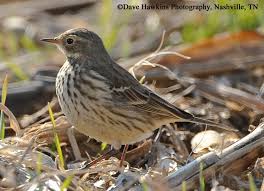
American Pipit
Photo Credit – Dave Hawkins, Tennessee Wildlife Reserve Agency
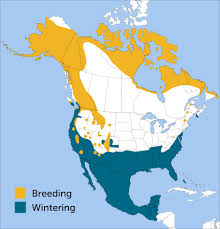
American Pipit Range
Photo Credit – American Bird Conservancy
The American Pipit was first considered the Old World species known as the Water Pipit, but ornithologists spun it off as a separate species in 1989. Like most pipits, it is a small, brownish, streaked bird with a sparrow-like appearance. It nests on the ground; its diet consists of insects taken from the ground or low plants and may also eat seeds. The typical lifespan is about five years. The breeding population is estimated at 20 million individuals, but there has been a 30 percent decline since the 1970s, possibly due to habitat loss and global warming affecting their breeding grounds.
The species is a winter visitor to California when it is seen in open country and lakeshores; however, some nest in the high Sierra Nevada during summer. The species may be seen in flocks of several hundred in open habitats or as solitary birds. They usually start to arrive and pass through the state in late September and return north by mid-May. Expect to see them on the ground, searching for food, with their tails bobbing. In 2024, the Siberian Pipit was split from the American Pipit because of its paler whitish underparts, reddish, not dark, legs and other minor plumage differences. It is migratory, so we have a new vagrant species visiting California.
In summary, it is challenging to differentiate between pipit species but to begin with, the location where you see them will give you a clue. Try not to confuse them with sparrows that feed on the ground; look for the pipits’ running antics, buff-colored breasts with streaks, white outer tail feathers, and thin bills. Sparrows have more conical bills. Be aware that some sparrows, like the Song Sparrow, Fox Sparrow and Savannah Sparrow, also have streaked chests.
Hopefully, this article will help you separate pipits from other birds, such as sparrows, larks, and thrushes, but determining which species of pipit is the more challenging part.

Tawny Pipit, a UK comedy film from 1944: a couple from a Cotswolds’ village rally local people to save two birds nesting in a wheat field during World War 2



